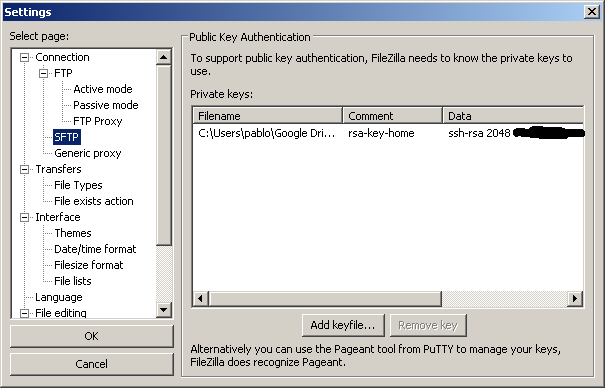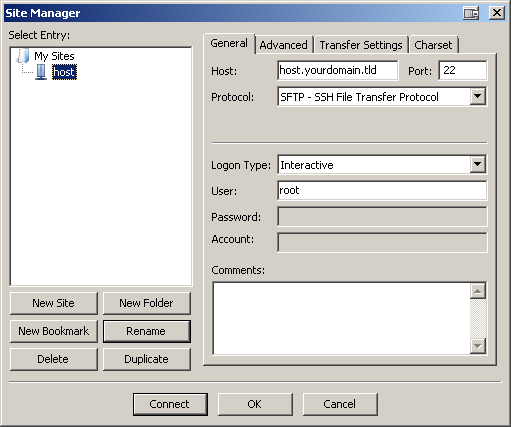Upload Files to Digital Ocean Ssh Key
Introduction
Are you a recent cloud hosting convert and find yourself struggling to figure out how to best manage the files on your showtime virtual private server (VPS)? Practice you find yourself intimidated by the command line? If so, yous will be happy to larn that FileZilla provides a user-friendly graphical interface that can securely transfer files to-and-from, likewise as move files around within, your VPS.
Secure Communication
The ii well-nigh common methods of deeply transmitting information betwixt two computers are the (i) Secure Shell (SSH) and (two) Send Layer Security (TLS), and its predecessor Secure Sockets Layer (SSL), cryptographic protocols. Both are public-key cryptography tunneling protocols that aim to create a secure, confidential commutation of data and connexion across a network (particularly the net). The encryption technologies used past both protocols are very reliable, and are (when configured correctly) nearly impossible for hackers to pause into. All the same, while both protocols provide similar services, they are not the same. In fact, they have several pregnant differences that are beyond the scope of this article.
Today, OpenSSH is a default software package found on Unix-like operating systems such as Mac OS X and Linux. Thus, programs or subsystems that are based on the SSH protocol will work "out-of-the-box" without having to become through the boosted steps of either purchasing or creating the requisite SSL document needed for sure modes of secure data transmissions via TLS/SSL.
FTP vs. SCP vs. SFTP vs. FTPS
When needing to upload or download files from your VPS in real time, you essentially have the following options:
- File Transfer Protocol (FTP);
- Secure Re-create Program (SCP);
- SSH File Transfer Protocol (SFTP); or
- FTP over TLS/SSL (FTPS).
FTP *not secure
Among the various file-transfer options, ane should never, ever, ever connect to a remote server via FTP; SCP and SFTP are just equally easy to use, simply provide much more security. In add-on, while FTP requires the installation of FTP server software such as vsFTP or ProFTP, both SCP and SFTP employ the SSH protocol and, as a result, will work "out-of-the-box" when connecting to a remote Unix-like machine, such equally Mac OS X or Linux.
SCP vs. SFTP
Given that both SCP and SFTP apply the SSH protocol in connecting to another computer, the two methods are fairly equal in regard to security. SFTP has a slight border in regard to efficiency, considering an interrupted file-transfer can resume where it left off in the event of a broken connection that is later re-established.
SFTP vs. FTPS
SFTP should non exist dislocated with FTPS, considering the two methods are incompatible with each other. While FTPS can provide equal security, it does require boosted steps to deploy if 1 does not already accept an SSL document.
SFTP Clients
There are several quality SFTP clients out there: Cyberduck, Filezilla or WinSCP, to name a few. This article, however, will focus on Filezilla – an open up-source (i.e. complimentary) FTP customer for Windows, Mac Bone 10 and Linux. In add-on to beingness able to download the program, the filezilla-project.org site also contains a documentation Wiki and a Support Forum.
Primal-based Authentication
With SFTP, you accept two user-authentication options when connecting to a cloud server: (i) passwords or (ii) SSH keys. For a word on the benefits of SSH keys over passwords and/or instructions on setting upwardly password-less logins on your server, please refer to How To Create SSH Keys with PuTTY to Connect to a VPS.
SFTP via SSH2 Key-based Authentication
FileZilla has a built-in cardinal direction page in the Settings dialog, which allows y'all to salve your Public (SSH) Key and to (deeply) automate the process of connecting to a remote server.
Prequisite
If y'all have yet to create an SSH key pair, you can practise so by following i of two DigitalOcean tutorials:
- Windows users: How To Create SSH Keys with PuTTY to Connect to a VPS
- Mac OSX & Linux users: How To Prepare SSH Keys
Follow these steps once you have an SSH fundamental pair that you would like to utilise to connect to your VPS:
- Open the FileZilla client.
- From the top of the home screen, click on Edit and select Settings.
- On the left side of the menu, aggrandize the Connection section and highlight SFTP.

- Click on the [Add keyfile…] button and scan your local machine's directories and select your Private Key file.
- Then, over again from the superlative of FileZilla's home screen, click on File and select Site Manager.
- Finally, on the left side of the Site Managing director, click on the New Site button and type a unique proper name under My Sites that will allow you to easily place this detail remote server in the future.

- At present, under the General tab, fill in the Host (with either an IP address or FQDN) and Port fields (default is 22).
- In the Protocol dropdown menu, select SFTP - SSH File Transfer Protocol.
- In the Logon Type dropdown menu, select Interactive.
Annotation for PuTTY users with passphrase-protected public keys: If your original .ppk file is countersign-protected, FileZilla will convert your .ppk file to an unprotected i when importing the key into FileZilla. As of version 3.0.10, a password-protected cardinal file is not yet supported.
If a password-protected key file is desired, FileZilla is able to utilize PuTTY's Pageant tool.
- Just run Pageant; in your organization tray, you will see the Pageant icon appear.
- Right-click on the icon and select Add Key and select your individual key (.ppk) file.
- So, follow the prompt to enter your passphrase.
- Finally, launch FileZilla and connect to your virtual private server via SFTP using SSH2 with a username and an empty password (do non forget to close pageant when y'all are done).
Editing Text Files
In managing your VPS, you will inevitably run across a state of affairs where some programming (text) files crave edits. FileZilla does not carry a born text editor, which gives you the freedom of using any text editor of your option. A pop editor among Windows users is Notepad++ because information technology is lightweight and tin work with many of today's popular programming languages.
By default, FileZilla is configured to utilise your local organisation'southward default editor. If you do non wish to make Notepad++ your system'southward default text editor, but would all the same like to use it to edit HTML, XML, Python, CSS, PHP & other programming files on your VPS:
- From the FileZilla home screen, click on Edit and select Settings.
- Forth the left side of the Settings window, highlight File editing.
- Then, select the radio push button associated with Use custom editor and click on the Browse button.
- Find your desired editor'south executable (.exe on Windows machines), double-click on it, and click the OK push button to relieve your changes & shut the Settings window.
<p><div form="author">Commodity submitted past: <a href="https://plus.google.com/107285164064863645881?rel=writer" target="_blank">Pablo Carranza</a> </div></p>
washingtonbrin1950.blogspot.com
Source: https://www.digitalocean.com/community/tutorials/how-to-use-filezilla-to-transfer-and-manage-files-securely-on-your-vps
0 Response to "Upload Files to Digital Ocean Ssh Key"
Post a Comment